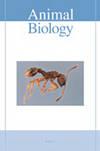Mating behavior and spermatophore morphology of the whip scorpion Typopeltis dalyi Pocock, 1900 (Uropygi, Thelyphonida)
IF 0.9
4区 生物学
Q2 ZOOLOGY
引用次数: 0
Abstract
Whip scorpions are an enigmatic group of terrestrial raptorial arachnids that show remarkable mating and courtship behavior in which the male forms a complex spermatophore. While whip spiders (Amblypygi) are relatively well-studied, whip scorpions (Uropygi) are poorly known. The two orders form the Pedipalpi, whip scorpions (Uropygi include Thelyphonida and Schizomida) and whip spiders (Amblypygi). Two major groups have been described based on the mode of sperm transfer that differ in the duration and mode of the typical female–male tandem mating dance. Because comprehensive studies are lacking, in this study we add to our knowledge of the reproductive biology of whip scorpions by analyzing the mating behavior and spermatophore morphology of the previously unstudied species Typopeltis dalyi Pocock, 1900. Our observations show that this species belongs to the second group and supports the hypothesis of P. Weygoldt that their mode of sperm transfer appears more effective than that of the first group and that sufficient sperm can be supplied with one mating. The mating behavior and spermatophore morphology in T. dalyi are similar to those of closely related species and add additional characters applicable for species classification and phylogenetic inferences.鞭蝎的交配行为和精囊形态研究,1900(尾形目,鞭形纲)
鞭蝎是一种神秘的陆生爬行纲蛛形纲动物,它们表现出显著的交配和求偶行为,雄性形成复杂的精囊。虽然鞭蛛(Amblypygi)的研究相对较少,但鞭蝎(Uropygi)却鲜为人知。这两个目形成了Pedipalpi,鞭状蝎子(Uropygi包括Thelyphonida和Schizomida)和鞭状蜘蛛(Amblypygi)。根据精子转移的模式,已经描述了两个主要的群体,它们在典型的雌性-雄性串联交配舞蹈的持续时间和模式上有所不同。由于缺乏全面的研究,在本研究中,我们通过分析先前未研究的物种Typopeltis dalyi Pocock的交配行为和精囊形态,增加了对鞭蝎繁殖生物学的了解,1900年。我们的观察结果表明,该物种属于第二组,并支持P.Weygoldt的假设,即它们的精子转移模式似乎比第一组更有效,并且一次交配可以提供足够的精子。达氏T.dalyi的交配行为和精囊形态与亲缘关系密切的物种相似,并增加了适用于物种分类和系统发育推断的额外特征。
本文章由计算机程序翻译,如有差异,请以英文原文为准。
求助全文
约1分钟内获得全文
求助全文
来源期刊

Animal Biology
生物-动物学
CiteScore
2.10
自引率
0.00%
发文量
34
审稿时长
3 months
期刊介绍:
Animal Biology publishes high quality papers and focuses on integration of the various disciplines within the broad field of zoology. These disciplines include behaviour, developmental biology, ecology, endocrinology, evolutionary biology, genomics, morphology, neurobiology, physiology, systematics and theoretical biology. Purely descriptive papers will not be considered for publication.
Animal Biology is the official journal of the Royal Dutch Zoological Society since its foundation in 1872. The journal was initially called Archives Néerlandaises de Zoologie, which was changed in 1952 to Netherlands Journal of Zoology, the current name was established in 2003.
 求助内容:
求助内容: 应助结果提醒方式:
应助结果提醒方式:


